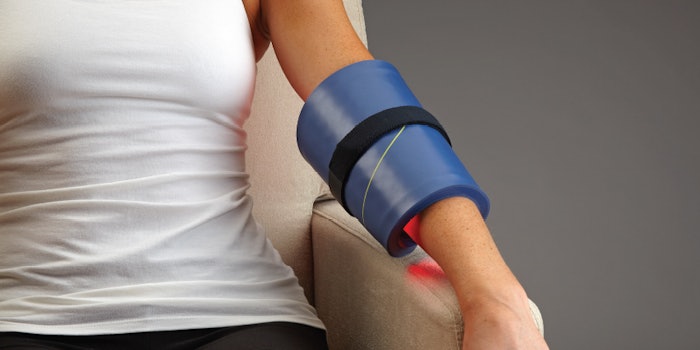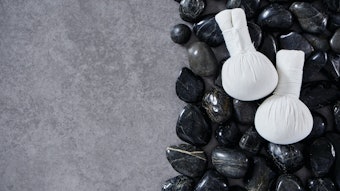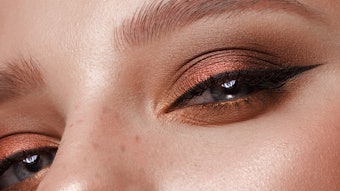
LED light therapy is part of almost every skin professional’s armamentarium for effective acne and anti-aging skin care routines. However, many professionals are now discovering that non-invasive LED light therapy is not just a great addition to skin health, but a valuable tool to help achieve whole body health as well.
Since LED light therapy combats inflammation and induces collagen production, it is a great option for those who suffer from general pain conditions. Let’s take a look at the head-to-toe benefits of LED light therapy.
How Light Therapy Works
One of the easiest ways to explain red and near-infrared light therapy is to think of it as photosynthesis for mammals. Just like plants, scientific research has shown that human bodies can absorb light particles called photons and transform that light energy into adenosine triphosphate (ATP). ATP is what powers the metabolic processes in our cells, thus improving overall cellular performance and encouraging tissue repair and regeneration. Quality medical-grade light therapy devices utilize three scientifically proven wavelengths: blue, red and near-infrared.
Just like plants derive energy from the sun through photosynthesis, light therapy uses specific wavelengths to stimulate a natural response in human tissue that can increase circulation, accelerate tissue repair, ease muscle pain, relieve joint stiffness, improve skin conditions and enhance overall cell performance at the cellular level. Light therapy boosts cellular performance to encourage and enhance the body’s ability to heal itself from the inside out.
Keeping Acne Breakouts Under Control
It is well known that LED therapy using light energy in the blue light range of the electromagnetic spectrum (400nm – 470nm) is effective in treating mild to moderate Acne vulgaris. When C. acnes bacteria is exposed to blue light energy, a phototoxic event is created, resulting in the death of the bacteria. Specifically, LED light therapy systems utilize the mechanism of endogenous photodynamic therapy, where bacterial porphyrins, which are produced as part of the normal metabolism of C. acnes, act as natural photosensitizers. When they absorb light, preferably wavelengths in the blue light and red light range, the resultant photodynamic reaction produces singlet oxygen species and reactive free radicals, which destroy the bacteria themselves. Essentially, the C. acnes bacteria commit suicide.
Blue light is the wavelength of choice for treating acne, as it is a short wavelength of light energy at the peak of the light energy absorption curve. The penetration of light energy is a function of the wavelength. As wavelengths get shorter, the light energy penetrates more shallow. As C. acnes bacteria resides close to the surface of the skin and blue light is shallow penetrating, blue light is ideal for killing C. acnes bacteria. And in the absence of C. acnes bacteria, you eliminate one of the fundamental sources of Acne vulgaris. This being the case, having a light therapy device that emits light energy in the blue range is essential for every skin care professional, as well as home users looking to eliminate their acne issues.
Managing Aches, Pains and Aging-Skin
Who wouldn’t like a little more collagen to help eliminate those fine lines and under eye wrinkles? But did you know that collagen plays a much larger role in how your body functions?
Collagen is defined as a protein that your body naturally makes. It actually makes up almost a third of all the protein in our bodies and is an essential component for healthy joints. Although most of us tend to think of collagen as the cure for under eye wrinkles and laugh lines, it is also accurate to think of collagen as the glue that holds together our muscles, bones, tendons, ligaments, organs and skin.
There are 16 different types of collagen in our bodies, but most are type I, II or III. Also, each collagen type has a different job to do.1 Type I builds skin, bones, tendon and ligaments. Type II helps make cartilage, the flexible tissues between bones and in our ears and nose. And Type III helps create muscles and blood vessels. Our bodies make less collagen as we age, which is why we have those stiff joints or weak muscles.
The use of red light therapy for increasing collagen production is highly effective, as it stimulates fibroblast growth factors and increases the production of ATP. This increase in ATP, pro-collagen and collagen synthesis, and increased blood flow can dramatically reduce fine lines and wrinkles. Proven red and near-infrared wavelengths of light energy are clinically verified to enhance your body’s natural ability to generate collagen and elastin by stimulating fibroblast cells.
When it comes to effective treatment of pain conditions with LED light therapy, wavelength is the key to success. Compared to blue light therapy, near-infrared wavelengths can penetrate deep into the muscle and joint tissue to alleviate pain, increase circulation and decrease inflammation. LED light therapy provides compromised cells with extra energy to accelerate the natural repair of compromised tissue cells, foster cell production and restore homeostasis within the body. Those suffering from arthritic pain can benefit from using an LED red light therapy that is FDA-cleared to treat the pain associated with arthritis.
Near infrared wavelengths are clinically proven to penetrate deep below the surface layer of the skin to better target muscle and joint pain right where it starts. This provides much needed pain relief from inflammation, injury and aging issues. For example, if you have ever suffered from the effects of arthritis, then you know the pain and discomfort this disease can cause. LED light therapy is a non-invasive, non-pharmaceutical alternative that can effectively treat arthritic pain.
Let’s Talk About Hair Loss
Hair loss isn’t strictly a male health concern. While suffering mostly in silence, women make up a significant percentage of those who suffer from hair loss. According to the American Academy of Dermatology, 40% of women have visible hair loss by the time they are age 40. Many procedures and products are marketed to help men with hair loss, while women are largely relegated to thickening shampoos and collagen supplements.
Hair loss in women (and in men) can have an emotional toll, impacting their self-image and potentially their mental and emotional well-being. For many men and women, hair loss can be a life altering condition.
Male pattern baldness, also known as androgenetic alopecia (AGA), accounts for 95% of hair loss in men. Research shows that by age 35, more than two thirds of American men suffer from hair loss and by age 50, 85% of men deal with thinning hair. Androgenetic alopecia is a common hair loss condition that is characterized by the miniaturization of hair follicles in the frontal and parietal regions of the scalp. All this means is that there are approximately 35 million men in the United States dealing with hair loss.
While many men have embraced the “bald is beautiful” mantra, there are others who suffer from male pattern baldness and are extremely unhappy with how they look, particularly men who begin balding at a young age. Many are desperate for solutions and for some, it can impact interpersonal relationships as well as their professional options.
The bottom line is that the market for real hair restoration solutions is booming. Light therapy compliments currently existing treatments and procedures (prescription drugs, PRP, stem cells, transplant surgery) to enhance an individual’s outcome for maximizing hair growth. When it comes to restoring hair loss, there are many treatment options such as the topical drug minoxidil. There is also the oral drug finasteride. However, surgery is expensive and many are looking for a drug free and pain free option to avoid unwanted side effects.
Low-level light therapy (LLLT) delivered by LED devices is a proven, effective and safe treatment for hair loss. It enhances hair growth by targeting and boosting the biochemical processes in the scalp and follicle. It is thought that through photobiomodulation, red light energy emitted by LLLT devices may encourage hair growth by accelerating keratinocyte and fibroblast mitosis, inhibiting nitric oxide and reducing inflammation.2-5
Clients can experience light therapy in a clinical setting, as well as purchase a suitable LED device to complete treatment in the convenience of their own home without repeated office visits. It is also non-invasive, non-toxic and painless. One review article from 2018 states “Relative effects show LLLT as the superior treatment” when comparing light therapy to the six most common non-surgical treatment options for treating androgenetic alopecia in both men and women including dutasteride 0.5 mg, finasteride, 1 mg, minoxidil 2%, minoxidil 5% and platelet-rich plasma (PRP).6
Full-Body Self-Care
As we begin to age, we all notice how the laws of gravity seem to turn on us. We quickly learn the lesson that aging is not limited to just the skin on our faces. Whether it’s the under eye wrinkles that make us look perpetually tired, the deep laugh lines around the mouth, or the saggy skin on our necks, anti-aging products fill the shelves claiming to tighten, firm or fill in those fine lines and wrinkles.
FDA-cleared, medical-grade light therapy devices work by up-regulating compromised mitochondrial function leading to a whole cascade of downstream beneficial effects including a decrease in inflammation and an increase in micro-circulation leading to therapeutic benefits for a wide variety of skin, muscle, joint and pain conditions (see Body Benefits of LED). Taken together, a whole-body approach to LED light therapy provides the following benefits:
Choosing the Right LED Device
With a bewildering number of new machines hitting the market, it is more important than ever to understand exactly what makes an LED device effective. Being able to decipher marketing hype from scientific parameters will make selecting a device a much less intimidating process. The following are the main guidelines based on proven scientific principles that apply to all LED brands.
First, choose a device emitting evidence-based wavelengths: blue, red and near-infrared. These wavelengths have been widely shown to increase ATP production in cells which are compromised due to aging, illness, disease or just unhealthy lifestyle choices. Blue addresses acne issues, while red and near-infrared decrease inflammation and increase micro-circulation to bring more oxygen and nutrients to the area. In esthetics, red and near-infrared are particularly desirable for their ability to stimulate fibroblast activity and boost collagen and elastin production. No other wavelengths are more broadly supported in credible scientific research.
Second, it’s important to remember that the efficacy of a light therapy session depends on the amount of energy absorbed by the cells during the treatment session. Laws of optical physics have established that the closer the light device is positioned to the skin, the more energy is absorbed. The amount of energy emitted at the surface of an LED device is not relevant. What is relevant, is how much is available for absorption at the skin surface and it needs to be in the range of 2-10 Joules per centimeter squared (acceptable range of energy delivery for an effective LED device).
Third, and something often not addressed, is the fact that pulsing adds a higher level of sophistication and effectiveness to an LED device, and its importance is often overlooked. Delivering the light energy in a pulsed manner has been shown in clinical literature to enhance the cell’s ability to absorb more energy over the treatment period. Choose a device that offers pulsing as an option.
And finally, treatment time matters too! It takes cells a certain amount of time to absorb enough energy to affect a change at the cellular level. The duration of the LED session should take this fact into account. High quality LED devices call for 20-30 minute treatment times to deliver a full therapeutic dose of energy, up-regulating cellular activity for up to 48 hours post treatment. This is how a quality LED device achieves observable change in skin, pain and wound conditions.
Head to Toe
From your head to your feet, LED light therapy is a valuable tool in your health care and self-care daily routine.
Denise Ryan, has over 30 years of sales, marketing and product management experience in dental and medical device manufacturing. She has been with Celluma since January 2012 as product manager, director of sales and currently serves as the global vice president of brand management.










